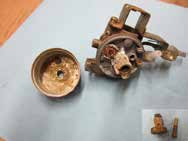Fuel Issues With Small Equipment
This is just a friendly reminder to start up and use your outdoor power equipment that has been sitting for a couple of weeks (especially generators, snowblowers, pressure washers and anything else that only gets used periodically). If it does not start, contact our specialists at Maintenance On The Move right away. Please read our recommendations for safe small equipment storage including 2-stroke and 4-stroke gasoline engines (lawn mowers, snowblowers, generators, tillers, pressure washers, trimmers, leaf blowers, chainsaws, and any other gas powered equipment).
Storing small engines and small equipment has changed in the last few years considering the use of ethanol in our gasoline. Ethanol eats away at all the plastic and rubber in the fuel system and forms varnish which permanently ruins carburetors. Ethanol also attracts moisture to the fuel which creates corrosion in the carburetor and causes the fuel to spoil rapidly; especially in moist environments with high temperature fluctuations. Engines with fuel damage usually run horrible, only run on choke or will not start at all. More than likely, a new carburetor will need to be installed, which can be costly.
Always read your owners’ manual for storage as manufactures tend to differ on safe storage procedures, but our general tips will minimize fuel breakdown issues and damage to your carburetor.
General Storage Procedures
- Remove and dispose of ALL the old fuel from the machine.
- Add a full tank of fresh gas to the engine (at least 95% full to prevent condensation and moisture buildup). Make sure it is fresh gas (less than 2 weeks old). If possible, use ethanol free gas.
- Add the recommended amount of fuel stabilizer to your tank of fresh gas. We recommend using brands like Sta-Bil or Seafoam. The label on the container will instruct you on how much to put into your gas tank.
- Run the engine for at least 10 minutes to get the fuel stabilizer into the carburetor. Then, turn the machine off and the fuel system is ready for storage.
- Every month, start the engine and run for at least 10 minutes. This will ensure that fresh fuel will always be in the carburetor. Make sure to keep the gas tank full of stabilized gas as you run it monthly.
- Continue starting the engine once per month for one year. When it comes to the first year, drain all the old fuel from the machine and start the whole process over again for years to come. The reason for this is because most stabilizers are only guarantied for up to one year of storage.
- A tune-up (which includes a fuel flush with ethanol free stabilized fuel) is highly recommended once per year to make sure the gas, oil, and filters are always clean and free from moisture and debris. Tune-ups help prevent costly repairs.
Helpful Hints
- If you notice the gas has a foul odor, a yellowish color to it, or the engine doesn’t start or run as well within one year, drain all the fuel and start the process over immediately.
- Complimentary to our annual tune-up service, Maintenance On The Move always performs a fuel flush with ethanol free stabilized fuel; before permanent carburetor damage occurs.
- Some experts suggest draining the fuel out of the machine for safe storage including the fuel that is left over in the carburetor bowl. We have found this method to be most effective when storing equipment for longer than a few years. It is also effective if you are storing equipment and you don’t have accessibility to run it once per month. The reason this method is not our primary recommendation is because we have seen carburetor seals and fuel lines get extremely dried out and dry rotted. Then when fuel is put into the engine, it can cause leaks until it is fixed.
- Please call one of our small engine specialists at Maintenance On The Move with any questions and to schedule your next tune-up!

This is a picture of a carburetor that is destroyed as the result of bad gas. It shows all the corrosion and varnish that permanently ruins carburetors internally. This is by far the most common issue that Maintenance On The Move specialists have been working with.
